
Cambridge - Its Railways and Station[Source:
Darren Kitson]
Part 10: Private Sidings For much of its existence Cambridge had numerous private railway sidings. Many were in the vicinity of the station but others were further out. As of 2015 only one still exists, albeit disused and disconnected; this is the oil terminal on the remaining stub of the Mildenhall branch. Some private sidings were little known when they existed, let alone today as the generations have come and gone. Others were proposed or requested but for various reasons were never built; an example of this, albeit just outside the Cambridge boundary, was a siding for the County Mental Asylum, Fulbourn which would have been literally a stone's throw from Teversham Siding which did exist (on the west side of the Bakers Arms - Teversham road). Of those that did exist but were little known was Hallack & Bond and Robert Sayle. The former has already been described but Robert Sayle is much better known for the former upmarket department store in the centre of Cambridge. Robert Sayle was a Norfolkman who opened his store on St Andrew's Street in 1840. The business gradually expanded by taking over neighbouring shops and was among the first department store type businesses in the country. Robert Sayle died in 1883 but the business continued and was taken over by Selfridges in 1934. In 1939 Selfridges sold the store to John Lewis but it continued trading under the Robert Sayle name until 2007 when it relocated, following a temporary move to Burleigh Street, to the Grand Arcade development close to its original location. It now trades under the John Lewis name. Details of Robert Sayle's railway siding are patchy to say the least. The earliest known record is from August 1857 and the siding is known to have been extended in 1858. At some point Robert Sayle had built a warehouse, apparently at his own expense, and a record survives from April 1964 stating that Sayle sold his warehouse to the GER for £7000 - a considerable sum of money those days - as it was required for use by the Midland Railway. The Midland had a siding at Mill Road and they also shared a goods shed with the LNWR at Brooklands Avenue but no information about this warehouse has so far come to light other than that it was either leased or rented by the GER to the Midland. A record also survives of complaints concerning Sayle's men "cutting across the station yard". Given that the station yard is for all intents and purposes a public area, the reason for these complaints is difficult to determine but it might be that Victorian attitudes dictated that workmen should not be seen in public areas unless it was necessary for the carrying out of their duties and "cutting across the station yard" suggests this was not the case. The mention of the station yard may yield a clue to the whereabouts of Sayle's siding and warehouse although the siding and the warehouse may not necessarily have been at the same location. The sale of the warehouse to the GER suggests it was underused or that its location, wherever that was, had proved unsuitable. At the time of writing, no further details are known. The Cambridge Manure Co. are on record as having a siding at Chesterton as early as 1857 but no other details are known.
Above is a list of sidings in Cambridge as of 1904 (from the Railway Clearing House Handbook of Railway Stations), the majority of which are private sidings. In some cases their purpose is indicated and in others it is not; for example, Beale & Co. were coal merchants, Beales, P & Co. were coal and corn merchants, Vinter was a coal merchant. Coote & Warren's siding as indicated above was north of Mill Road on the down side. They also had a coal yard adjacent to and north of Hills Road bridge. Foster Brothers, it will be noted, had sidings on both the GER and GNR. These were the sidings described in an earlier part of this feature which were once linked via wagon turntables and a track running through the mill. Some of the locations may appear a little vague, especially where running over other companies lines was concerned. Mill Road Wharf, for example, although not a private siding as such, is given as 'Over G.E. from St. Ives Junction'. This refers to the route Midland Railway trains took; St. Ives Junction being the junction at that station where the Huntingdon and Kettering line branched off. Hallack & Bond's siding is given as between Cambridge and Lords Bridge which was true but its actual location was in the area bounded by Brooklands Avenue and Trumpington Road. Other sidings appeared at later dates. Atlas Concrete, Saxon and Norman Cement Works all had sidings connected to the post 1896 Newmarket line although the Atlas works was connected internally to the Saxon siding. Cyril Ridgeon, timber and builders merchants, had a siding serving their Cromwell Road premises while Travis & Arnold, in the same line of business, later occupied the former Midland siding at Mill Road Wharf. The LNER, in 1928, provided a siding for the Co-op. This was located on the down side north of Mill Road and adjacent to the Corporation siding. Its track was still in situ in the 1980's albeit disused. In December 1931 the LMS were discussing a warehouse for Cadbury Brothers, the chocolate people. No record has come to light of this warehouse actually being built but it is known to have existed as BR records from 1954 mention it being moved to a new site in that year. This was the siding and warehouse located between Mill Road and Coldham's Lane, on the down side and just before the gas works sidings. It was better known locally as the Fry's or Cadbury-Fry warehouse, Fry having merged with Cadbury way back in 1919. The new warehouse was in use only for a very short time and as a result became a target of much criticism. Both it and the gasworks sidings have now been obliterated by a retail park. The brickworks sidings were later taken over by scrap merchants (Coldham's Lane) and coal merchants (Barnwell). Today no trace remains. Perhaps the best known private siding was that of the gas works because, unlike most others, it was in full public view. The siding opened in 1869 and was horse-shunted by the gas companies own horses until, it is thought*, 1929 when a Sentinel steam locomotive was purchased which shunted the gasworks sidings at Coldham's Lane until the gasworks closed in 1969. Its job was to push loaded coal wagons into the wagon tippler and then form up trains of empties ready for BR to take away. Your author has some experience of this locomotive, being able to drive it at weekends at Cambridge during its final year in service. This was not exactly official, it must be admitted, and done under the watchful eye of one of the regular drivers, Fred Mason. Fred was your stereotypical locoman; greasetop cap, overalls and always with a tale to tell. *It is unclear if horses worked until 1929 or if, at some point prior to the Sentinel arriving, a locomotive was hired-in but horses are believed to have worked until 1929.
The 1964 1:2,500 OS map above shows the gasworks sidings in relation to Coldham's Lane and the main railway lines. Note the correct spelling of Coldham's Lane, with apostrophe. The railway junction was - and still is - known as Coldham Lane Junction. As we have seen, the sidings opened in 1869 but the Sentinel locomotive did not appear until 1929 and the engine shed, built at the same time, can be seen towards the top left. The structure marked 'Hopper' contained the wagon tippler; here wagons were bodily upturned to discharge their contents which were then transferred by a bucket conveyor to an overhead hopper. Coal was then loaded into road lorries, which ran as a constant shuttle, to be taken to the gasworks about a third of a mile away on Newmarket Road. (see map below) Cambridge gasworks was one of the very few supplying larger towns not to have a direct rail connection. Lorries entered the sidings site via the gate to the right of the hopper, loaded and then set off for the gasworks via the gate near the engine shed. At the bottom of the map the connections to the down relief road of the main line can be seen . The tippler was probably installed at the same time as the Sentinel arrived but this particular detail is unconfirmed.
Compare this view to the details shown on the map. The date is unknown but as the shed for the Sentinel is present, lower left, it is possibly 1949 - 1950. The structure containing the wagon tippler and hopper can also be seen, together with a rake of wagons - probably empties awaiting collection. On the left the chimney and pit, apparently flooded, of the brick and tile works can be seen. It would thus appear the works has closed and sometime after became the site of Richard Duce's scrapyard. At bottom right the houses of Silverwood Close can be seen. Coldham's Lane bridge had replaced a level crossing in 1896 and the small building to the lower right of the bridge was either the crossing keeper's accommodation, although it was rather small to have been residential,.or, more likely, a coal office. There was once a coal yard south of Coldham's Lane and parallel to the main line and this may have been the original gasworks sidings. (see OS 1880 1:500 Town Plan below) This layout would by necessity have been altered when Coldham's Lane level crossing was replaced by the bridge, with the result being the gasworks sidings as seen on this page. The building still survived in the late 20th century if not later. At centre right the railway sidings which in 1958 became the site of Cambridge diesel depot can be seen. At the top, the Newmarket line curves away across Coldham's Common; first recorded during the 14th century, it was designated Common land during the 17th century when, incidentally, it was used as an isolation area for plague victims who were housed in temporary 'pest houses'
The gasworks Sentinel was very different in appearance to the Y1/Y3 (See Part 5) and looked more like a conventional locomotive as opposed to the shed on wheel's appearance of the Y1/Y3, but mechanically it had the same type of vertical boiler, engine, gearing and chain drive. From memory it was permitted to move seven or eight empty 16 ton coal wagons or four loaded wagons but being diminutive and handbraked-only it took some skill to stop it with the loaded wagons in the right position on the tippler. The tippler was driven by a National gas engine. Power output of the gasworks sentinel was 100bhp. It burned coke whereas the Y1/Y3 burned coal. Given the very similar equipment, the performance of the Y3s was probably much the same as the gasworks sentinel when working the same types of wagon. This gives an idea of the usefulness, or otherwise, of the LNER / BR Sentinels. But for departmental work, which could be of an intermittent nature, they were ideal and those at Cambridge only succumbed with the arrival of diesel shunters.
Several images of the gasworks Sentinel when still at Cambridge exist but all which have been seen depict the other side of the locomotive, that is, the non-chain side. The above view, at the Ribble Steam Railway, Preston, Lancashire (always worth a visit but check the website for opening times), shows the chain side. Also visible is the chain from the power unit to the leading axle. She was Sentinel Works No.8024 of 1929. A small shed, brick, was built for the locomotive at the west end of the sidings but the locomotive would only just fit inside. It was provided with a pit and other basic facilities and always had the mandatory spare bicycle tyre hanging from a hook. For many years at Cambridge, the Sentinel was painted in a rather drab all-over shade of green but a much lighter shade than those BR used. It was more of a grass green. During its last year or so at Cambridge it was painted in the then corporate gas board livery of blue and white. The water tank was white and it bore the Eastern Gas name and the familiar flame logo. This livery suited the little Sentinel rather well. Today the inevitable retail park covers the site of the sidings (and other former rail connected premises) and a supermarket now occupies the site of the gasworks. The square box in the front of the running plate is a sandbox. There was one each side and sand was fed to the front pair of wheels only. The bell-shaped device may or may not be original, your author does not recall this device being present at Cambridge. The whistle is mounted vertically; at Cambridge it was mounted horizontally and was always rather watery sounding.
The Sentinel locomotive is seen above outside its shed, probably in the early - mid 1960s. The locomotive was in all-over green livery at this time. The vertical boiler can be seen in the cab, as can a bucket of coke. No bunker was fitted. The regulator was on the other side of the cab, as was the handbrake which is just visible. Hanging beneath the footplate a chain can be seen; this was used when dropping the fire and the shed was provided with a pit for this purpose. Note the 1929 datestone above the shed entrance. The shed was fitted, latterly at least, with a roller shutter door painted in the same shade of green as the locomotive. It is not known if the shed was fitted with a water tank but probably not as it is known the usual method of filling the locomotive's water tank was via a hosepipe. Coldham's Lane can be seen in the background and the site of the Mobil garage is now occupied by a carpet and furniture retailer. The site of the engine shed is now partly an empty plot of land behind Silverwood Close and partly occupied by the rear of 'The Beehive', another retail building and one which is supposed to look like a beehive but is more resembling of a giant woodlouse. The gasworks Sentinel has survived into preservation, having been originally purchased from what had become Eastern Gas by Mr Gerald Pagano. Gerald was a Saffron Walden businessman who had, around the same time, attempted to purchase Black 5 No.44781. The latter had been used in The Virgin Soldiers film but although Columbia Pictures offered to sell the locomotive to Gerald for a "reasonable sum" (Gerald's own words at the time), the price quoted by BR for re-railing and towing away of the locomotive from Bartlow, the location of the film scene, thwarted Gerald's plans. Thus No.44781 was cut up on site at Bartlow by A. King & Son. It is worth adding that contrary to common belief, No.44781 was undamaged and in working order, although not in steam, at Bartlow. The film scene portrayed locomotive and train derailed, supposedly blown up by explosives, whereas in reality Cambridge breakdown crane was responsible by simply lifting No.44781 off the suitably torn-up track and lowering it again at a suitably convincing angle beside the track. Black 5 No.44781 was the final non-preserved BR steam locomotive to be seen at Cambridge, albeit not in steam. When Mr Pagano purchased the Sentinel for preservation he named it Gasbag and it is still referred to by that name today. Mr Pagano made, or had made for him, a pair of Gasbag nameplates but what happened to them is something of a mystery. They appear to have simply vanished.
Further along the Newmarket line were the Atlas Concrete works and the Saxon and Norman cement works. At the bottom of the 1928 image above is the Atlas works and immediately above it the Saxon works. The Atlas and Saxon works were internally rail connected. The connection with the Newmarket line was beside the signal box visible just above the Saxon works. Hardly anything is known about this box. Coldham's Lane can be seen meandering from top to bottom of the image on the left and the railway was on embankment at this point. This made the connection into the works rather awkward, witness the siding dropping down beside the embankment. Today housing, a supermarket and Brooks Road covers the site. The rail connection between the Atlas and Saxon works crossed Cherry Hinton Brook on a bridge, the remains of which were still visible in the 1980s.
At the top of the image which is looking east, is the Norman cement works and to its right the trackbed of the original Newmarket line can be seen, later obliterated by quarrying. The land to the left of Coldham's Lane is now part of Cambridge Airport while much of the other land seen above is now either lakes (the flooded former quarries), housing or commercial developments. During WWII the GHQ defensive line ran left to right just above the two quarries in the centre of the image. Click here to see the Simplex which once worked at the Saxon Cement works and later at the Norman works. Your author remembers it dumped out of use in the engine shed at the latter works.
Click here for Part 11: Getting to and from the station
|
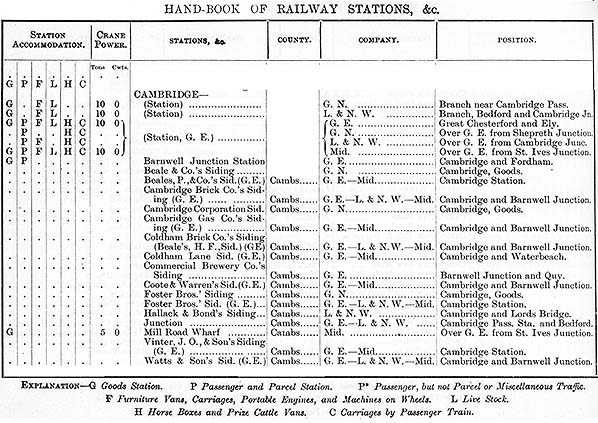


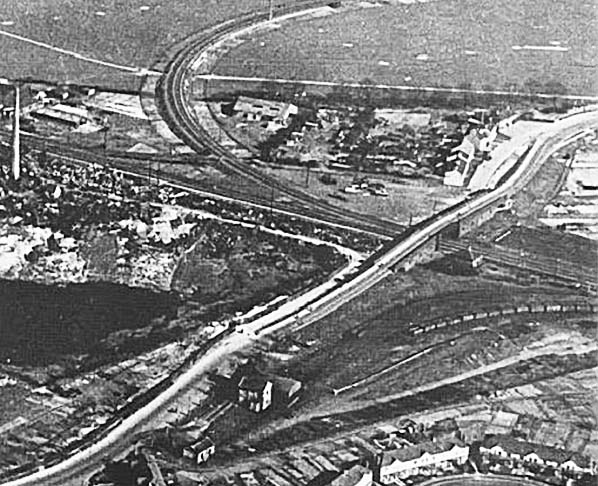

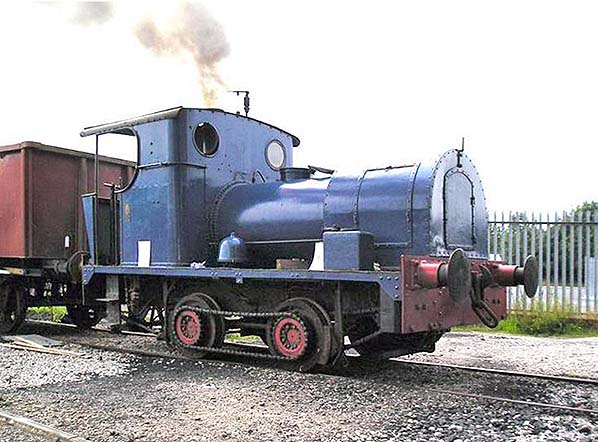
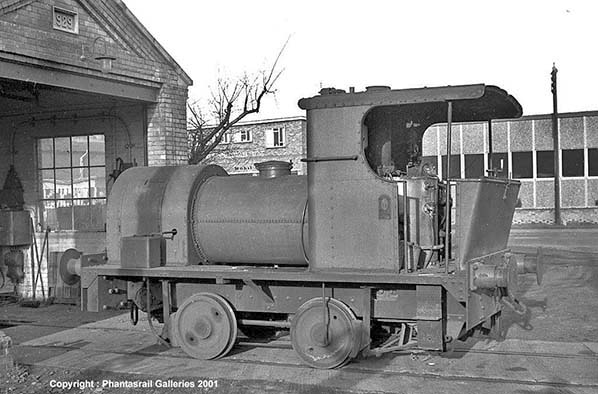
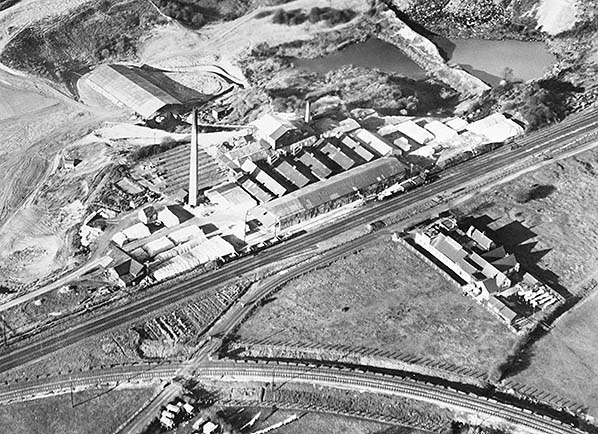
 The above aerial view dates from 1928 and shows the Brick & Tiles works immediately north of Coldham's Lane; the bridge being just out of view bottom left. The Brick & Tile works had one of several private sidings between Mill Road and Barnwell Junction. The site later became a scrapyard and today is covered by a retail park with no trace whatsoever of its industrial past remaining. The Newmarket line can be seen curving across the bottom of the image.
The above aerial view dates from 1928 and shows the Brick & Tiles works immediately north of Coldham's Lane; the bridge being just out of view bottom left. The Brick & Tile works had one of several private sidings between Mill Road and Barnwell Junction. The site later became a scrapyard and today is covered by a retail park with no trace whatsoever of its industrial past remaining. The Newmarket line can be seen curving across the bottom of the image.

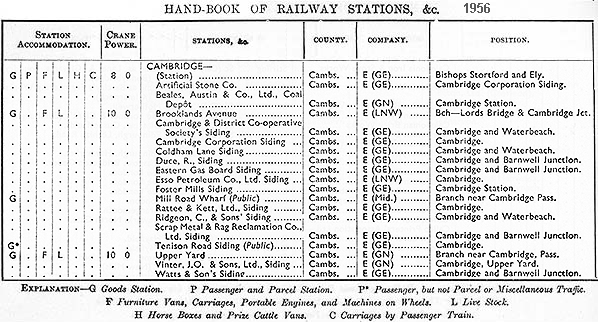

 Home Page
Home Page